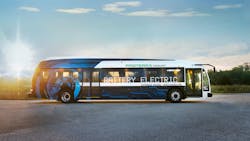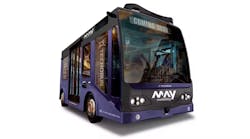Autonomous Vehicle Technology: Preparing for the next wave of innovation in public transit
More than a decade ago, Proterra set out to build a bus for the future of public transit, a vehicle free from the constraints of legacy fossil-fuel bus design. Recognizing that the right bus for a post-fossil fuel world wouldn’t be a repurposed diesel bus, we started with a clean sheet of paper and a Federal Transit Administration (FTA) grant and designed a bus that was optimized for performance as an electric vehicle. This vision required significant innovation, with the development of a lightweight, durable composite body, the industry’s most advanced battery design, a drivetrain far more powerful than a diesel and the vehicle control systems to make it all work seamlessly. We’ve also needed to take our innovation beyond the bus, with better charging, financing, training and maintenance services, enabling our customers to make a smooth transition to electric fleets.
Since our founding, the industry has looked to Proterra as a trusted partner to lead the way on technology, a responsibility that we take very seriously. As electric vehicles increasingly become a mainstream option, government entities and leading transit agencies are now preparing for the next wave of innovation in public transit – autonomous vehicle technology. Increased automation for buses promises to improve safety, operations and efficiency, while also addressing congestion in cities. Automation will also help with parking and charging buses, maximizing depot space and enabling smart charging as a cost-effective measure.
The transit industry continues to support innovation and recognizes the possibilities bus automation can offer communities. The American Public Transportation Association (APTA) created a new Connected and Automated Vehicle Committee to facilitate the deployment of these technologies by outlining the technical, institutional and policy considerations associated with deployment. U.S. Department of Transportation Secretary Elaine Chao announced at SXSW a new Non-Traditional and Emerging Transportation Technology Council to address regulatory barriers that may impede growth and development of new technology like automation. Additionally, the U.S. Department of Transportation issued Automated Driving Systems Demonstration Grants which provides federal funding for demonstration projects that test the safe integration of automated driving systems into the nation’s on-road transportation system. The FTA has also previewed funding opportunities and technical assistance to supplement partners’ deployment and evaluation activities in its Strategic Transit Automation Research (STAR) Plan.
We’re seeing great innovation across the surface transportation industry when it comes to automation – literally sometimes right outside the window in our Silicon Valley office. As automation develops, however, there is a growing awareness of potential risks if not deployed responsibly. For example, it is widely believed that vehicle automation will result in a massive expansion of vehicle miles traveled (VMT). Accordingly, increased automation of passenger cars threatens to increase congestion to unbearable levels, while the automation of fossil-fuel buses could drive harmful emissions much higher. Due to these and other factors, it’s becoming clear that autonomous vehicle technology will find its best application in electric buses, addressing both congestion and emissions concerns and ensuring that clean, quiet transportation is accessible to all.
At Proterra, we believe in making the transit bus better because, more than any other form of transportation, battery-electric buses are the cornerstone in addressing the future of mobility and sustainability for cities. Whether it's addressing congestion, sustainability or equity – investment in public transportation and zero-emission buses is a must for modern cities.
Here are some exciting applications we see for electric bus automation:
- Advanced Driver Assistance – Bus transit is already comparatively safe compared to the personal car and one of the important benefits automation can provide is further enhancing safety. Transit operators manage more variables during their routes than any other driver on the road. Automation can provide support when it comes to detecting and reacting to potential safety concerns. This can include automatic emergency braking for collision avoidance, precision movement for narrow lanes and smooth acceleration and deceleration.
- In-depot Automation – Automation provides a unique opportunity to improve operational efficiency and safety in bus yards. Automation will power precision movement for electric buses to provide an automated assist with parking and recall, charging, maintenance and washing. This will lead to maximizing parking space in the depot and minimizing charging hardware and infrastructure investment.
- Platooning – Led by a lead bus with an operator at the wheel, automation will enable several buses to follow behind in close proximity, creating a “platoon.” With platooning, transit agencies could flexibly increase rider capacity during peak hours by virtually connecting two or more standard transit buses, reducing aerodynamic drag and improving fuel efficiency of the vehicle. With more route flexibility and at a lower cost, cities may consider electric Advanced Rapid Transit (ART) service utilizing platooned electric buses as an alternative to light rail.
- Fully Autonomous Bus – This is what most people think of when considering autonomous vehicle technology. The autonomous bus of the future will need to accomplish both driving and non-driving tasks, including many tasks that autonomous passenger vehicles do not need to incorporate such as assistance for older adults and people with disabilities, fare collection, and help with passenger navigation.
For many years, Proterra has been developing and testing the connected vehicle technology that will form the basis for increased automation. Since our earliest days, Proterra vehicles were designed with driver assist features to help with charger docking. Nearly two years ago, Proterra initiated the industry’s first autonomous bus program with the University of Nevada, Reno and its Living Lab Coalition partners including the Regional Transportation Commission of Washoe County (RTC). With new autonomous applications in mind, Proterra stands ready to demonstrate and deliver the technologies that will enable our industry to confidently step into the future.
As we continue to develop our efforts in automation, we’ll be sharing updates on partners, projects and more.
Ryan Popple is president and CEO of Proterra.



